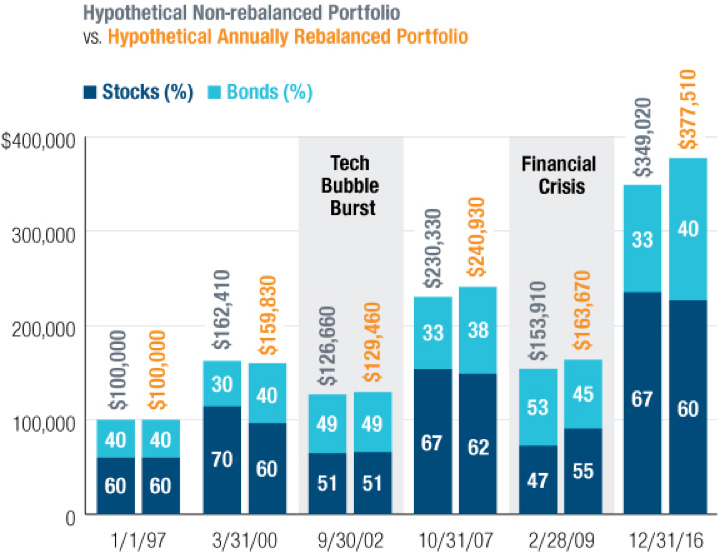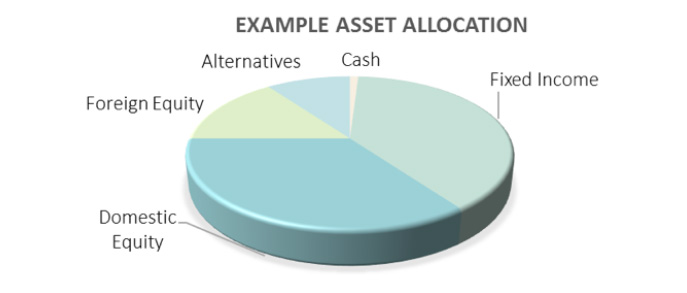With the stock market on an eight-year bull run, many investors grin, pat themselves on the back and wait for the lines on the charts to thrust higher. After all, it’s been years since they lost a dime. Pullback talk has circulated for many months but the market keeps setting records.
Colleagues at work talk about how their holdings have grown and many feel the same way. To the stars!
One person interjects a puzzling remark: Has anyone rebalanced? Most of the group frown. “Rebalancing? With the market this hot? Why not let it run? We’ve had phenomenal success!” is the refrain.
Whether the person’s co-workers understand the concept may be irrelevant. But if they don’t consider rebalancing, their bull market ride could get bumpy. Many investors know what rebalancing means and are glad they do!
Rebalancing is the realignment of the weightings of a portfolio of assets. It means buying or selling assets in a portfolio so as to maintain an original plan of asset allocation. Rebalancing is different for each investor, depending on which kind of risk and return is being sought. Before making a decision, an investor should review his or her investment policy to make sure they still have the same goals.
Some Points to Consider
- What am I trying to accomplish in the long term with my portfolio?
- How much risk am I comfortable with taking?
- Will rebalancing increase my portfolio return over the long run?
Discipline is important in investing and is essential for rebalancing. It ensures that the investor looks at his or her portfolio at least once a year, if not more often. Some advisors also say rebalancing shouldn’t necessarily be set at a particular time, such as around the start of a new year. Keeping a close eye on the portfolio year around will enable one to pick up signals that indicate when to best rebalance.
Let’s look at an example. Investor A started with an original asset allocation of 50% stocks and 50% fixed income. But when stocks perform strongly, the proportion can become lopsided. A strong market boosting stock value could create a portfolio valued at 70% equities and 30% fixed income. Depending on the investor’s risk tolerance and the term of portfolio needs, some rebalancing should be considered to return to the original asset allocation.
Rebalancing takes the guesswork out of which asset class will outperform. It requires a disciplined approach to a fixed mix of portfolio assets, as well as a determined interval or percentage change for the rebalancing.
LET’S TALK ABOUT RISK
Risk aversion plays a big part in rebalancing. Again, one’s investment policy can be a guide for both a good and a bad market. In a good market, an investor should not get too risky. When rebalancing, take gains from areas that have done well and move them to areas that have lagged or gone out of favor. For example, in a bad equity market, moving funds from a fixed income portfolio can help stock values recover more quickly when the equity market turns around.
Illustrating with the last two major downturns, the chart below examines two hypothetical portfolios each started with $100,000 invested on January 1, 1997. One was rebalanced annually (in yellow) to the original allocation over the next 20 years; the other (gray) was not rebalanced at all. The rebalanced portfolio declined less in bear markets, was less volatile over the entire 20-year period, and outperformed the non-rebalanced portfolio.

Source: T. Rowe Price.
Another important benefit of rebalancing comes from keeping the allocation in line with the original allocation targets. This allows the investor to maintain their chosen level of risk. Risk level is based on one’s risk tolerance, time horizon and other financial planning considerations. For example, most people will want to reduce their portfolio risk gradually as they get older by reducing the percentage of their money in equities. Basing portfolio risk and systematic rebalancing on an investor’s long-term financial planning keeps market movements from causing haphazard changes in one’s portfolio risk level.
DIVERSIFICATION
Diversification is another way to rebalance and to guard a portfolio against risk. This involves deciding on the general asset class mix between equities, fixed income and cash, which are a blend of assets that normally don’t move in the same direction.

A portfolio can hold a variety of industries such as energy, technology, manufacturing or health care. Companies with a large capitalization can be mixed with medium and small capitalization company stocks. Domestic stocks and foreign stocks can be part of the mix.
Generally, it isn’t prudent to hold too many assets that are affected by the same factors at the same time. A downturn can wipe out a lot of value. To illustrate, holding 10 different technology stocks is not diversification.
SO…WHY REBALANCE?
Psychologically, rebalancing is counter-intuitive and difficult for many investors. One might say to their advisor, “You really want me to sell my winners and buy more of those losers that haven’t done anything for me recently?” Investors think this way because human intuition tells us to follow trends and buy more of what has done well and sell what has done poorly. This can cause buying high and selling low – the opposite of what investors should do. Rebalancing is an automatic way to buy low and sell high, without emotions getting in the way.




